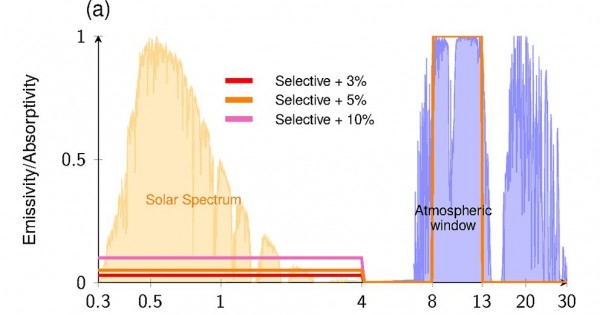Greenhouse gases are named after greenhouses because both of them warm the space under them by allowing sunlight to pass downward but not allowing infrared radiation to pass upward.
What if we could find a sort of password that would give infrared rays a pass through the atmosphere? Could we beam some of our excess heat out into space, which is so cold and vast that the heat would effectively vanish?

A team of Stanford scientists reports a new nanomaterial that can do that. At the same time, it is a sort of hypermirror, highly reflective of visible light. They don’t yet envision enough production of this material to completely neutralize global warming, but they think we can at least cool buildings with it in hot parts of the world.
If it pans out in production, it could become nearly ubiquitous and improve everyday life for several billion people. The report describes work that was more or less theoretical, but they have begun work on a real prototype, funded by ARPA-E.
They say panels of this “metal-dielectric photonic structure” can be built in existing factories, and should be about as effective (in terms of energy per area) as solar photovoltaic panels—but without any wiring, any moving parts, or any need for air conditioner units that have their own limited lifespans. (And with the bonus of permanently beaming up at least a little bit of our excess heat.) They would work completely off the grid—in villages without electricity, for example.
Panels covering 10% of a roof could take care of 35% of the cooling needs of the building underneath. I’m not an engineer and can’t tell you if that can be extrapolated to 29% of the roof area taking care of 100% of the cooling.
The trick with the infrared radiation is that there is a small portion of the infrared spectrum that has just the right wavelength to slip through the greenhouse gases in the atmosphere. The scientists engineered a material based on very abundant minerals—quartz and silicon carbide—to emit infrared mainly within that wavelength “window.”

Part of the trick resides in the “folded band structure of semi-infinite slabs of silicon carbide and alpha-Quartz.” Great phrase! Scientists Eden Rephaeli, Aaswath Raman, and Shanhui Fan reported their findings in the March issue of Nano Letters. Rephaeli and Raman are PhD candidates, and Fan is their professor.
“We’ve taken a very different approach compared to previous efforts in this field,” Aaswath Raman told another reporter. “We combine the thermal emitter and solar reflector into one device, making it both higher performance and much more robust and practically relevant. In particular, we’re very excited because this design makes viable both industrial-scale and off-grid applications.”